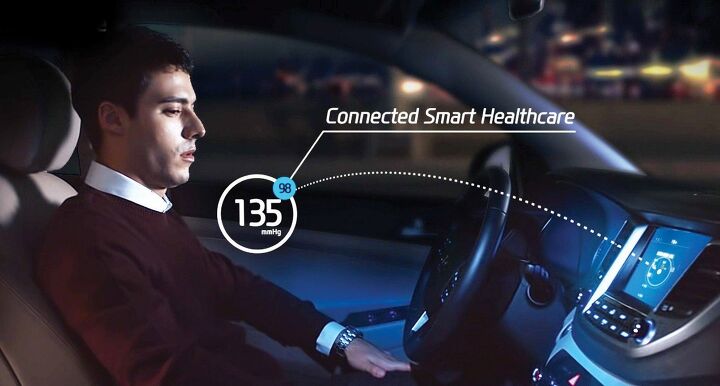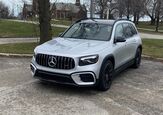It's Blissss: Hyundai is Eagerly Looking at Ways to Control Your Emotions

The stresses of everyday commuting and travel can really get to you. All that time wasted while idling in traffic. Stomping your brakes as another driver makes a left on a red light directly in front of you. Or perhaps sitting behind someone in the left lane of the freeway, puttering along at 57 miles per hour. You can finish your journey much more triggered than when you set off.
Hyundai understands the frustration you experience with other drivers, and they’re preparing to offer their own brand of sedative if necessary.
Introduced last month at the 2017 Consumer Electronics Show (CES), Hyundai’s Health + Mobility Cockpit (or Healthcare Cockpit) is all about monitoring and controlling your emotions while driving. Much like an ever-watchful therapist, the idea behind the concept is to connect mobility and wellness through the creation of an in-car environment conducive to increased focus or relaxation.
Hyundai envisions a car full of different sensors that monitor the physical and mental states of the driver. Tracking driver posture, breathing habits, heart rates, eye movements, and facial feature recognition are all on offer here. Alertness and emotional state are gathered through these variables, and the car will then formulate an appropriate response. To regulate the driver, Hyundai has created a multi-sensory mood experience.
The automaker calls these “Mood Bursts.” They’re special changes which take place inside the car to help adjust a driver’s mood. The bursts are temporary in nature, and are designed to deliver “contrasting moments rather than prolonged environmental change.” Sort of like those contrasting moments when you hop out of your Suburban after your solo commute, but choose to recycle your empty can of Monster Energy rather than toss it in the trash bin.
Hyundai has highlighted five different areas where there could be a reaction from the Health + Mobility Cockpit, depending on need:
- Posture: If the posture sensor detects the driver is losing their focus or alertness (no slouching!) the seat can automatically adjust to a more upright position. If irritation or discomfort is detected, active lumbar goes to work, massaging the driver’s back to put them at ease.
- Smell: When the monitoring systems notice a driver needs a change of mood, different scents can be pumped through the cabin. Lavender or eucalyptus are calming if you feel a bit of rage happening, and peppermint or cedar can work if you seem a bit sleepy or ho-hum.
- Light: Variable lighting temperatures emanating from the dash can stimulate the driver, causing increased alertness.
- Temperature: The ambient temperature inside the car is part of the monitoring system, and it can automatically be adjusted to direct warmer or cooler air at the driver to alter responsiveness. A blast of cold air to the face always peps you up a bit, doesn’t it?
- Sound: Indicated as one of the most effective experiences, the Healthcare Cockpit can work with music and radio apps to create either calming or alertness environments. Perhaps you’d enjoy hearing The Carpenters in high traffic situations, or a White Snake alert burst at 2:30 A.M.
Hyundai will allow the driver some control of the mood, however:
Hyundai’s health and mobility concepts allow drivers to intentionally shift modes for increased personal productivity or relaxation. Many distractions are inside the car, so the Healthcare Cockpit uses [some] modes to help drivers be both safe and productive without having to take their eyes off the road.
There are four distinct modes the driver can select: Enrichment, Connection, Reflection, and Check-list. Enrichment focuses on bringing you new “discovery playlist” material through the audio system. Connection allows hands-free chats with family and friends, reducing isolation and allowing you to settle fights between your kids at home, even during your solo commute! Reflection is a personal voice recorder, allowing the driver to record their thoughts and inspirations for later use. Now, Check-list sort of exists already, as it’s about accomplishing small tasks through voice commands and phone integration.
Hopefully soon, all cars will help you slow your roll during your drive. We’ve only just begun.
[Healthcare Cockpit Images: Hyundai]

Interested in lots of cars and their various historical contexts. Started writing articles for TTAC in late 2016, when my first posts were QOTDs. From there I started a few new series like Rare Rides, Buy/Drive/Burn, Abandoned History, and most recently Rare Rides Icons. Operating from a home base in Cincinnati, Ohio, a relative auto journalist dead zone. Many of my articles are prompted by something I'll see on social media that sparks my interest and causes me to research. Finding articles and information from the early days of the internet and beyond that covers the little details lost to time: trim packages, color and wheel choices, interior fabrics. Beyond those, I'm fascinated by automotive industry experiments, both failures and successes. Lately I've taken an interest in AI, and generating "what if" type images for car models long dead. Reincarnating a modern Toyota Paseo, Lincoln Mark IX, or Isuzu Trooper through a text prompt is fun. Fun to post them on Twitter too, and watch people overreact. To that end, the social media I use most is Twitter, @CoreyLewis86. I also contribute pieces for Forbes Wheels and Forbes Home.
More by Corey Lewis
Latest Car Reviews
Read moreLatest Product Reviews
Read moreRecent Comments
- Akila Hello Everyone, I found your blog very informative. If you want to know more about [url=
- Michael Gallagher I agree to a certain extent but I go back to the car SUV transition. People began to buy SUVs because they were supposedly safer because of their larger size when pitted against a regular car. As more SUVs crowded the road that safety advantage began to dwindle as it became more likely to hit an equally sized SUV. Now there is no safety advantage at all.
- Probert The new EV9 is even bigger - a true monument of a personal transportation device. Not my thing, but credit where credit is due - impressive. The interior is bigger than my house and much nicer with 2 rows of lounge seats and 3rd for the plebes. 0-60 in 4.5 seconds, around 300miles of range, and an e-mpg of 80 (90 for the 2wd). What a world.
- Ajla "Like showroom" is a lame description but he seems negotiable on the price and at least from what the two pictures show I've dealt with worse. But, I'm not interested in something with the Devil's configuration.
- Tassos Jong-iL I really like the C-Class, it reminds me of some trips to Russia to visit Dear Friend VladdyPoo.





































Comments
Join the conversation
I don't need any help from Hyundai. I can cure most of my ills anytime I get behind the wheel of my 69 Mach I and drive for either business or pleasure.
I think I've seen this line in a few sci fi stories.